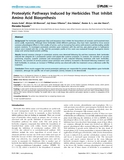Mostrar el registro sencillo del ítem
Proteolytic pathways induced by herbicides that inhibit amino acid biosynthesis
| dc.creator | Zulet González, Amaia | es_ES |
| dc.creator | Gil Monreal, Miriam | es_ES |
| dc.creator | Villamor, Joji Grace | es_ES |
| dc.creator | Zabalza Aznárez, Ana | es_ES |
| dc.creator | Hoorn, Renier A.L. van der | es_ES |
| dc.creator | Royuela Hernando, Mercedes | es_ES |
| dc.date.accessioned | 2017-04-11T21:19:42Z | |
| dc.date.available | 2017-04-11T21:19:42Z | |
| dc.date.issued | 2013 | |
| dc.identifier.issn | 1932-6203 (Electronic) | |
| dc.identifier.uri | https://hdl.handle.net/2454/24093 | |
| dc.description.abstract | Background: The herbicides glyphosate (Gly) and imazamox (Imx) inhibit the biosynthesis of aromatic and branched-chain amino acids, respectively. Although these herbicides inhibit different pathways, they have been reported to show several common physiological effects in their modes of action, such as increasing free amino acid contents and decreasing soluble protein contents. To investigate proteolytic activities upon treatment with Gly and Imx, pea plants grown in hydroponic culture were treated with Imx or Gly, and the proteolytic profile of the roots was evaluated through fluorogenic kinetic assays and activity-based protein profiling. Results: Several common changes in proteolytic activity were detected following Gly and Imx treatment. Both herbicides induced the ubiquitin-26 S proteasome system and papain-like cysteine proteases. In contrast, the activities of vacuolar processing enzymes, cysteine proteases and metacaspase 9 were reduced following treatment with both herbicides.Moreover, the activities of several putative serine protease were similarly increased or decreased following treatment with both herbicides. In contrast, an increase in YVADase activity was observed under Imx treatment versus a decrease under Gly treatment. Conclusion: These results suggest that several proteolytic pathways are responsible for protein degradation upon herbicide treatment, although the specific role of each proteolytic activity remains to be determined | en |
| dc.description.sponsorship | A. Zulet and M. Gil-Monreal received funding from Spanish fellowships through the Ministerio de Educación and the Universidad Pública de Navarra, respectively. This work was financially supported through grants from the Spanish Ministry of Education and Science (AGL-2010-18621) and Max Planck Society and the COST Action CM1004 for funding. | en |
| dc.format.mimetype | application/pdf | en |
| dc.language.iso | eng | en |
| dc.publisher | Public Library of Science | en |
| dc.relation.ispartof | PLoS ONE 8(9): e73847 | en |
| dc.rights | © 2013 Zulet et al. This is an open-access article distributed under the terms of the Creative Commons Attribution License, which permits unrestricted use, distribution, and reproduction in any medium, provided the original author and source are credited. | en |
| dc.rights.uri | http://creativecommons.org/licenses/by/4.0/ | |
| dc.subject | Proteolytic pathways | en |
| dc.subject | Glyphosate | en |
| dc.subject | Imazamox | en |
| dc.subject | Herbicides | en |
| dc.subject | Amino acid biosynthesis | en |
| dc.title | Proteolytic pathways induced by herbicides that inhibit amino acid biosynthesis | en |
| dc.type | Artículo / Artikulua | es |
| dc.type | info:eu-repo/semantics/article | en |
| dc.contributor.department | Ciencias del Medio Natural | es_ES |
| dc.contributor.department | Natura Ingurunearen Zientziak | eu |
| dc.rights.accessRights | Acceso abierto / Sarbide irekia | es |
| dc.rights.accessRights | info:eu-repo/semantics/openAccess | en |
| dc.identifier.doi | 10.1371/journal.pone.0073847 | |
| dc.relation.projectID | info:eu-repo/grantAgreement/MICINN//AGL2010-18621/ES/ | en |
| dc.relation.publisherversion | https://dx.doi.org/10.1371/journal.pone.0073847 | |
| dc.type.version | Versión publicada / Argitaratu den bertsioa | es |
| dc.type.version | info:eu-repo/semantics/publishedVersion | en |
| dc.contributor.funder | Universidad Pública de Navarra / Nafarroako Unibertsitate Publikoa |



